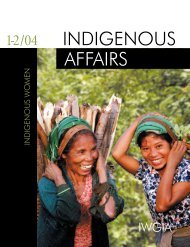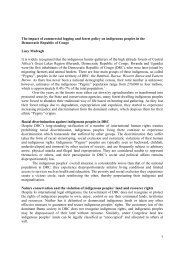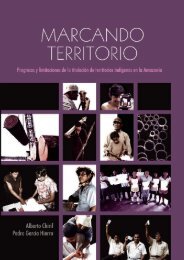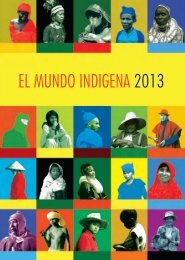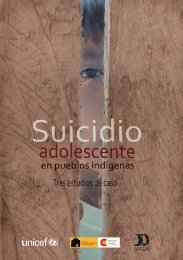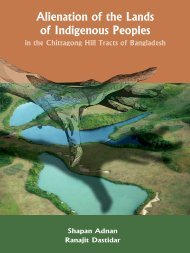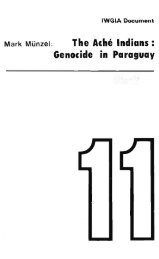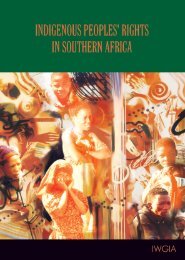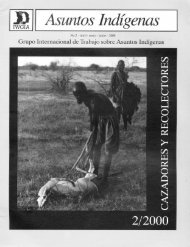Download (pdf) - iwgia
Download (pdf) - iwgia
Download (pdf) - iwgia
You also want an ePaper? Increase the reach of your titles
YUMPU automatically turns print PDFs into web optimized ePapers that Google loves.
10 See, for example, L Juma “Reconciling African customary law<br />
and human rights in Kenya: Making a case for institutional reformation<br />
and revitalization of customary adjudication processes”<br />
(2002) 14 Saint Thomas Law Review 505.<br />
11 See report prepared by EI Daes “Indigenous peoples and their<br />
relationship to land: Final working paper” UN Doc E/CN.4/<br />
SUB.2/2001/21(Daes final working paper), 144 para 40-48.<br />
12 Anaya 2004, 142.<br />
13 See part II ILO Convention No 169; Art 26 UN Declaration on the<br />
Rights of Indigenous Peoples; see also Länsman v Finland, Communication<br />
No 511/1992, UN Doc CCPR/C/52/D/511/1992,<br />
para 9.5; see also Human Rights Committee, General Comment<br />
23, Art 27 (55th session, 1994), Compilation of General Comments<br />
and General Recommendations Adopted by Human<br />
Rights Treaty Bodies, UN Doc HRI\GEN\1\Rev.1 (1994) 38,<br />
para 7.<br />
14 See, for example, sec 115(2) and 117(5) of the repealed 1963 Constitution<br />
of Kenya; See also sec 69 Kenya Trust Land Act (Cap<br />
288).<br />
15 ACHPR & IWGIA 2005, 21.<br />
16 Anaya 2004, 142.<br />
17 Daes final working paper, 78; see also “Report of the Special<br />
Rapporteur on the situation of human rights and fundamental<br />
freedoms of indigenous people: Kenya” by Stavenhagen, R.,<br />
Special Rapporteur of the Commission on Human Rights, submitted<br />
in accordance with General Assembly Resolution 60/251,<br />
U.N. Doc. A/HRC/4/32/Add.3, 26 February 2007 (Stavenhagen<br />
Kenya Mission Report) para 25.<br />
18 See the recommendation of the African Commission on Human<br />
and Peoples’ Rights on the case of the Centre for Minority Rights<br />
Development (CEMIRIDE) on behalf of the Endorois Community versus<br />
Kenya, Communication 276/2003, (Endorois case); Endorois<br />
case, para 238.<br />
19 Sec 115 (2) of the Repealed Constitution of Kenya 1963; see also<br />
sec 3 Judicature Act Laws of Kenya Cap 8: The High Court, the<br />
Court of Appeal and all subordinate courts shall be guided by<br />
African customary law in civil cases in which one or more of the<br />
parties is subject to it or affected by it, so far as it is applicable<br />
and is not repugnant to justice and morality or inconsistent with<br />
any written law, and shall decide all such cases according to substantial<br />
justice without undue regard to technicalities of procedure<br />
and without undue delay.<br />
20 Ibid.<br />
21 The only law purporting to legitimize communal land tenure is<br />
the Land (Group) Representatives Act which, as will be illustrated<br />
in the next section, is in real terms a formal extension of<br />
the individualization of land tenure in the name of group ranches.<br />
22 Sec 114-120 of the repealed Kenya Constitution of Kenya.<br />
23 See I Lenaola, H Hadley H. Jenner & T Wichert “Land tenure in<br />
pastoral lands” in C Juma and JB Ojwang (ed) In land we trust,<br />
environment, private property and constitutional change (1996) 242.<br />
24 Sec 115-116 of the repealed Constitution of Kenya.<br />
25 See J Kieyah “Indigenous peoples’ land rights in Kenya: A case<br />
study of the Maasai and Ogiek people” (2007) 15 Penn State Environmental<br />
Law Review, 2007 406; see also S Coldham “Landtenure<br />
reform in Kenya: The limits of law” (1979) 17 Journal of<br />
African Modern Studies 620.<br />
26 Land (Group Representatives) Act (Cap 287).<br />
27 See J Ngugi “The decolonization-modernization interface and<br />
the plight of indigenous peoples in post colonial development<br />
discourse in Africa” (2002) 20 Wisconsin International Law Journal<br />
345; see also Lenaola 1996, 245.<br />
28 See J Kieyah “Indigenous peoples’ land rights in Kenya: A case<br />
study of the Maasai and Ogiek people” (2007) 15 Penn State Environmental<br />
Law Review, 2007 406; see also S Coldham “Landtenure<br />
reform in Kenya: The limits of law” (1979) 17 Journal of<br />
African Modern Studies 620.<br />
29 Ngugi 2002, 347; see also Lenaola1996 247.<br />
30 Mwangi “The transformation of property rights in Kenya’s Maasai<br />
land: Triggers and motivations” (2005) 35 International Food<br />
Policy Research Institute, CAPRi Working Paper 11, 7.<br />
31 SC Wanjala “Land ownership and use in Kenya: Past, present<br />
and future” in SC Wanjala (2000) Essays on land law: The reform<br />
debate in Kenya: University of Nairobi. Nairobi, 35 citing sec 27<br />
and 28 of the RLA and Obiero v Opiyo (1972) EA 227; and Esiroyo<br />
V Esiroyo (1973) EA 388; see also L Cotula and B Neve “The driver<br />
of change” in L Cotula (ed) Changes in customary land tenure systems<br />
in Africa (2007) 33.<br />
32 See sec 211(3) Constitution of South Africa.<br />
33 See art 66 of the Constitution of Namibia.<br />
34 See Communal Land Reform Act No 5 of 2002.<br />
35 See Constitution of Kenya, 2010; section 29(4): Any law, including<br />
customary law, which is inconsistent with this Constitution<br />
is void to the extent of the inconsistency, and any act or omission<br />
in contravention of this Constitution is invalid.<br />
36 South African Constitution Act 108 of 1996, section 2; This Constitution<br />
is the Supreme law of the Republic: law or conduct inconsistent<br />
with it is invalid, and the obligations by it must be<br />
fulfilled.<br />
37 Constitution of Kenya 2010, 1 article 44.<br />
38 Constitution of Kenyan 2010, article 56.<br />
39 Section 63 Constitution 2010.<br />
40 See Republic of Kenya, Report of the Commission of Inquiry into the<br />
Illegal/Irregular Allocation of Public Land, Government Printer,<br />
Nairobi, 2004, 16.<br />
41 See section 25(7) of South Africa’s 1996 Constitution; “Report of<br />
the Special Rapporteur on the situation of human rights and fundamental<br />
freedoms of indigenous people: South Africa” by<br />
Stavenhagen, R., Special Rapporteur of the Commission on Human<br />
Rights submitted in accordance with Commission on Human<br />
Rights resolution 2005/51, U.N. Doc. E/CN.4/2006/78/<br />
Add.2 ,15 December 2005, para 37:<br />
42 See T Roux “The Restitution of Land Rights Act” in G Budlender,<br />
J Latsky & T Roux Jutas new land law (1998) chapter 3.<br />
43 See sec 1 of the Restitution of Land Rights Act; see discussion of<br />
the impact of the expanded definition of a “right in land” in the<br />
Act in Van der Walt, A J (2005) Constitutional property law: Cape<br />
Town: Juta & Company Ltd, 292-293.<br />
44 Ibid.<br />
45 See also Richtersveld Community and others v Alexkor Ltd and Another<br />
2001 (3) SA 1293 (LCC) para 6; see also T Roux “Pro poor<br />
court, anti-poor outcomes: Explaining the performance of the<br />
South African Land Claims Court” (2004) 20 South African Journal<br />
of Human Rights 522.<br />
46 Alexkor Ltd and the Government of the Republic of South Africa v<br />
Richtersveld Community 2003 (12) BCLR 1301 (CC) (South Africa)<br />
para 50-82.<br />
47 Ibid para 62 & 64.<br />
48 Ibid para 51.<br />
49 Ibid para 51.<br />
50 See sec 39 (2) Constitution of South Africa; see also Ibid para 51<br />
(referring to customary law) see also para 7 n.8 stating that customary<br />
law is synonymous with indigenous law.<br />
51 Sec 39 (2) Constitution of South Africa.<br />
52 See Mabuza v Mbatha 2003 (7) BCLR 43 (C) para 32.<br />
53 Sec 211 (3) Constitution of South Africa.<br />
54 Sec 39 (3) Constitution of South Africa.<br />
55 Alexkor v Richtersveld community (CC).<br />
56 TW Bennett Human rights and African customary law (1995) 148;<br />
see also Richtersveld v Alexkor Ltd (LCC) para 48 where the Court<br />
intimated that the doctrine of indigenous title was an alternative<br />
remedy to restitution under the Restitution Act but fell outside<br />
the LCC’s jurisdiction, a position since overturned by the SCA<br />
and the CC.<br />
57 See Mabo v Queensland (No 2) (1992) 175 CLR 1(Australia), 58.<br />
14 Indigenous Affairs 1-2/10



